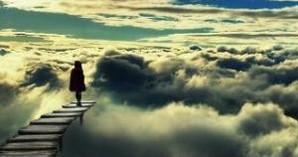The journey from Kathmandu to Varanasi , India Nepal , George (U.K.) turned out to have approximately the same route planed for India
After 10 extremely painful hours on the bus we finally got to the Nepalese side of the Indian border. I was freezing cold, my joints were stiff and deadly painful and the lack of sleep was wearing on me. We got off the bus determined to make our way to the immigration office on our own, and the rickshaw drivers constantly nagging us did not come across as helpful at that time. After wandering around in the dark for a while we understood that we had no concept of which way the border was, let alone how far it would be to walk. We gave in and jumped in a rickshaw, changed our Nepalese rupees into Indian and hoped that we would make it in one piece as the rickshaw rode down a pitch black road with no light indicating we were on the road to the cars and moped passing an inch away from us. It turned out that the border actually was almost a 15 minute ride away and we were glad we didn’t attempt it on foot.
The Nepalese immigration office was hidden away inside a random house in the border town and I’m not sure we would have found it had we not been pointed towards it. Carrying our heavy bags, still half asleep and fairly uncertain what to do how and where, we walked into the gate to “check out” of Nepal
The difference between Nepal and India Varanasi
As the villages and the countryside passed the bus kept filling up even thou it never stopped. The best and only way to board a bus is at speed, so timing is everything. It is also safe to say that the recognition of the term “full bus” does not exist in this country. When I thought the bus was completely packet as far as my western eyes could see, they still managed to squeeze another 30 ppl on. As we were the only white ppl on the bus we drew a lot of attention and sunglasses are a blessing when having at least 20 pair of eyes fixed on you for about 10 hours. Not only am I white and blond, but I was also breaking a strict cultural rule; I was only wearing a tank top, in other words, my shoulders were showing. At this point we’d reached midday and roasting alive. I was drenched in sweat and thirsty beyond thirsty, and the thought of putting on a t-shirt to shake off some stares would tip me over the top. Since the stops were few and short and everyone was fighting to squeeze one butt cheek on to the corner of a seat, the image of what would happen if I actually left my seat to use the toilet would be close to a stampede. Hence no toilet breaks. I was seated next to the window so I was hoping to get some air, but being a rookie in Indian transportation I wasn’t swift enough to opening the window which slides sideways before the guys in front and back of me had opened theirs, and therefore jammed shut both my sources to fresh air. It was time for lunch and I had another peanut butter sandwich, only this one didn’t do its magic as the others had done. Only 5 more hours to go…
Around 5.30 pm we finally arrived in Varanasi Varanasi for you and we had been warned that the traffic in Varanasi is as crazy as it gets in India Varanasi we would be fine anywhere in India
We ended up reaching the area we initially wanted to go to before we got sidetracked by yet another guy telling us that there was a very nice place to stay right around the corner. Reaching desperation and mentally drained from the traffic we decided to check it out. It turned out that right around the corner is a 10 minute walk around many corners before you find yourself far away from what actually was the finish line. Both George and I had lost our patience at this point walking around with our huge backpacks in the humid weather, and we took off heading for the Ganges which we knew would take us back to where we wanted to go. The same guy was following us recommending a place right around the corner for every ghat (platform or steps leading towards the Ganges river) we got to. When we got to the main ghat we popped into the first hotel we reached and asked for a room. The location of the place was good, but the room was shabby as hell. As an extra addition to our lucky streak the biggest Hindu festival, Diwali, was also taking place, where Varanasi India India
I’ll give it four weeks to work its magic.


.jpg)